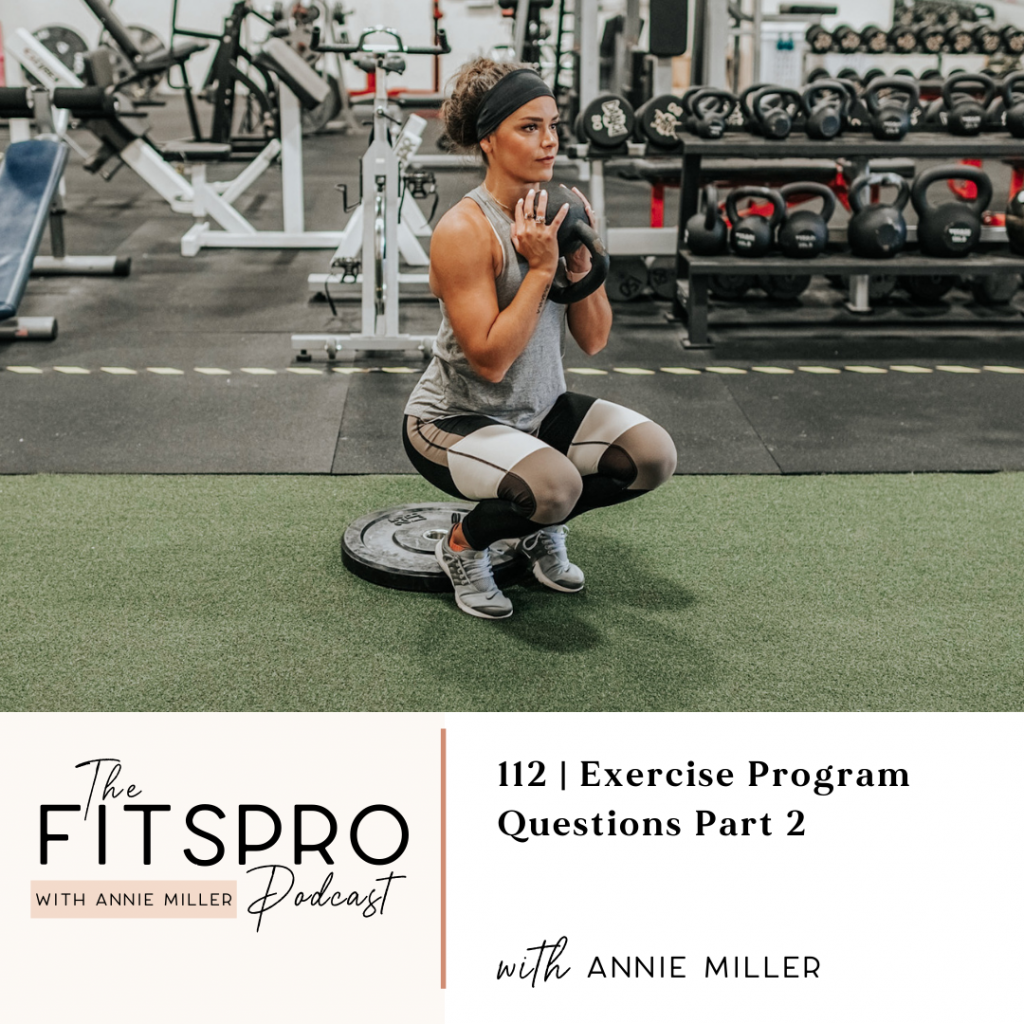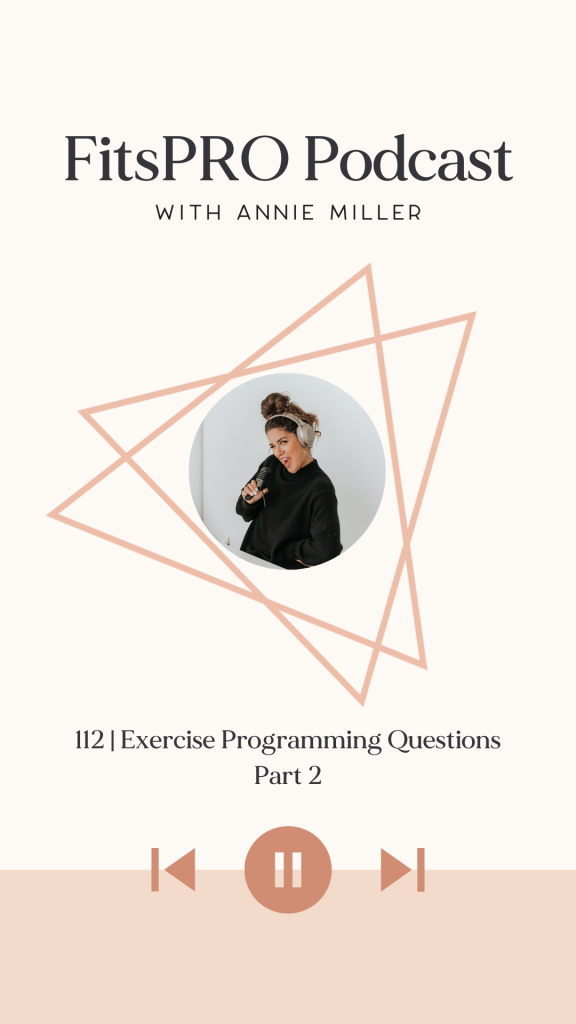the blog
welcome to
looking for something specific? find it here
Podcast: Play in new window | Download (Duration: 20:25 — 28.1MB)
Subscribe: Google Podcasts | RSS

112 – Programming Q’s Part 2
If you’re here for the business side of things, then go ahead and join my free on demand workshop, Your Biz | Your Way – 3 steps to build a profitable online health and fitness biz.
And while you’re on the site, snag all the free resources – you’ll find goodies for trainees and coaches or entrepreneurs alike. Much love.
This is a two part series, answering programming questions from the gram fam. In the previous episode, we covered the following questions:
- How you set up individual periodization for 1:1 client?
- What are your first step during intake and how do you execute them? Assessments
- What movements to assess during initial assessment
- How to assess for imbalances & How to work through muscle imbalances
- Logic to pairing movements – SUPERSETS/TRI SETS
- How to know how to include different movements (vertical, horizontal presses/etc) / Push pull ratios
- Controversial movements (pull behind the neck etc)
- When a client experiences tightness, how to modify/communicate?
- How to order movements
So go back and listen to that if you missed it. I did order these somewhat in a sequential manner. So we started with assessments and things of that sort. Now we are getting into training protocol, muscle groups, frequency and so on.
Alrighty, let’s get started with programming part two:
Best strength training protocol
I am not aware if there is a BEST strength protocol according to literature.
But some tried and true methods for strength are wave loading, and Wendler 5.3.1.
A lot of 1:1 programs look similar, is it wrong if two look the same? similar?
In short. No. It is very normal for 1:1 programs to have similar structure.
With time, you’ll figure out what leads to successful outcomes. You’ll repeat parts of this in multiple programs. If you use 10-20 exercises, there will be a similar use of exercises and structures.
As long as it fits the goals, assessments, and accessibility of the client, you’re good.
How often to train given muscle groups?/How often to hit the same muscle groups
Generally speaking minimum of 5-7 days between hitting the same movements and or muscle groups.
Put simply, we need enough to to recover between lifts but not so long that we aren’t experiencing progressive overload.
With that, think of weekly vs daily volume as well. You can destroy a muscle group in one sitting and wait 5-7 days to touch it again, or train multiple sessions per week with less destruction. Remember soreness is not a prerequisite for muscle growth.
Mechanical tension is your main pusher of hypertrophy. So hitting a muscle group every 3-7 days should allow you to progress and recover from mechanical tension.
There is no finite answer to this.
Generally speaking, every 5-7 days at minimum.
Should you always test workouts before programming for a client?
No. But also, I think this is far more important when you’re a young coach or interning. There is truth to practicing what you preach in a literal sense. I know what my BBA clients feel like when they perform high volume, oxidative squats because I’ve done them. I know what it feels like to pair hip thrusts with Bulgarian split squats or do cardiac power output intervals because I’ve done them.
With that, I’ve not done every BBA lift, right?
I’ve experienced and researched segments.
But when you’re starting I think it’s wildly beneficial to try your programming out.
- To feel it, and time it vs what it looks like on paper,
Things can slip by you like having a horizontal pulling day after a deadlift day. The spinal erectors can be a huge limiting factor here. I know because I’ve made this mistake.
All you can think about on bench and horizontal pulling is how freaking fatigued your erectors, and maybe even your grip, are.
Been there. Trying your own sets and reps or exercise pairings is a fantastic way to learn. Though I do not at all think you need to try every program before you send it out. Absolutely not.
How do you go about choosing specific movements over others when they work the same muscles?
This comes very much so down to preference. Of you as the programmer and that of the client if it’s 1:1.
I’m 100% open to having a client choose a different exercise if it gets the job done and gives the same stimulus I was going for.
Some considerations to make – and this is why having a basic understanding of anatomy and physiology is so important – is if the exercises are actually a similar stimulus or if they just work the same muscle.
Take the RDL and Hamstring curl vs a pull up and lat pull down.
Hamstrings are both worked in an RDL and hamstring curl. But what’s the difference in those two exercises?
One is prioritizing stress in the hamstrings as it LENGTHENS (RDL) and the other is prioritizing the SHORTENING contraction of the hamstring.
How can we see this?
Where is the fulcrum? Or pulley located? What joint does the action take place at?
With an RDL, it’s the hips.
With the curl, it’s the knee.
You see?
This is in a very long way around, how I decide on what exercises to choose when looking at the same muscle group.
There are many things to consider. Including what other muscles are involved and things of that sort.
Hope that helped. Or got your brain going.
How to go about long term periodization? / Exercise selection over a year long training program
Long term periodization is my fav. It’s what I learned and focused on in school and my time in college strength and performance.
I’m not an expert. I’m not the best. But I love it. And am happy to share what I know.
When looking at programming structure, we have micro, meso, and macro cycles.
- Micro is one month or block.
- Meso is 3-4 months
- Macro is 1 year +
So we’re looking at macro cycles – how to program for 12 months.
For reference this is the format I use in all three Built By Annie programs.
They’re built in a 12 month cyclical format. Meaning you can cycle through the same 12 month program and continue to make gains.
I personally start this process but looking at the primary goal of each MESO cycle.
Is it a strength block? Hypertrophy? Power? Building Capacity?
Mind you there are SO MANY things you could focus on. These are broad topics as examples. They’re a starting point.
So, I start wide, birds eye view.
Make sure the progression from meso cycle to meso cycle makes sense. That were not jumping from an endurance block to strength. Etc.
Then within each meso cycle plan out your micro cycles (each month within the meso cycle).
I like to start with the volume of the MAIN lift, then go into accessory, and warm ups.
I know it’s a lot. But that’s why I am working on a course on this stuff. To break it down and provide progression to learning programming. We’ll see if I can make it happen. And more importantly make it understandable and applicable.
How to get through a plateau
We can plateau from overtraining/under recovering, or from a lack of progressive overload.
Assuming someone has been adherent to their programming I’d recommend taking a deload week or changing the stimulus.
How to keep progressing a client in a movement pattern but keeping things diverse
Change up what you can outside of that movement pattern, and use exercises your client finds fun or prefers. Ask your client for requests. Bring them into the process and build efficacy.
Progressive overload is so confusing to me
I would need to ask what is confusing or overwhelming about it.
We can use:
- Tempo
- Volume
- Load
- Intensity
- Range of motion
To elicit progressive overload. The primary goal is to add MORE or DIFFERENT mechanical tension to the muscle fibers than they’ve previously experienced.
Warm up/cool down
I don’t know what this question was but imma say something about it.
I am for a daily repeatable full body warm up for a few reasons.
It builds awareness, predictability, and allows an athlete to get their head in the lift. It’s a daily baseline to see how they’re feeling before they load their body.
I use something called movement prep as the lift specific warm up. That applies to the main movements of the day and any mobility we want to address.
There’s normally core work in there too.
Cool downs have been said to be helpful in bringing the body from a sympathetic to parasympathetic state vs suggesting that DOMS or muscle damage is less.
How/when to progress online clients through phases
4-6 weeks general speaking. Some 1:1 coaches program week to week, especially if you’re working with an injury or something that needs week to week consideration. But 4-6 weeks should get the job done.
There you have it! 22 programming questions answered. Idk if you’re more confused or less confused, but what’s done is done.
Programming, and fitness in general is one of those things where as you learn you realize how much you still don’t know. Ya know? It’s not a bad thing. We can not have all the answers and still product quality programs.
We can be learning and product solid programs. This is always the goal, yes?
If you find value here, on The FitsPRO Podcast, then pretty please head over to iTunes, subscribe, rate and review the show. It means the world to me when you spread my message to more humans.
Want more podcasts? Click here to skim the archives.
P.S. Save this value packed episode for later over on Pinterest!
ALL THE LINKS YOU NEED:
Free On Demand Workshop: 3 Steps To Build a Profitable Online Health and Fitness Business
Supplements: Legion Athletics Code ANNIE for 20% off
Skincare: Fré Skincare Code FDBA for at least 15% off
Bags: Vooray Code ANNIE for 20% off
I'm an adventurous introvert from Vancouver, Washington who lives on sleep + "me time." I'm a lover of lifting weights, dinosaurs, real talk and traveling with my husband. I am here to help you move better, lift more, bust the myths of the fitness industry, and inspire you to love the process.
Hey you,
The name's Annie & you're reading my thoughts. Let's get acquainted.
the whole story >
looking for something specific? find it here
THE LINKS BELOW ARE AFFILIATE LINKS
SKIN CARE
Nutrition
brands I love
working against gravity
Fre skin care
favorites
blue light blockers
klassy network
code: fdba saves you 15% off
online TRAINERS
save $50
code: ANNIE saves you 20% off
You love my style, trust my reviews, and want more Annie Miller Concepts vibes in your life? Shop my favorite brands. You get awesome products and yours truly gets a little kick-back.


